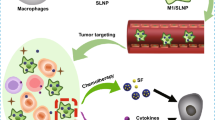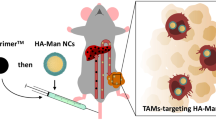Abstract
The interaction between cancer cells and M2 tumor-associated macrophages (M2-TAMs) facilitates tumor growth and metastasis. However, cancer cells and M2-TAMs have different spatial distribution patterns, which requires distinct drug delivery strategies. Herein, based on different tumor-penetrating ability of nanocarriers, we developed a combinatory strategy that consists of a TAMs-targeting liposome (alanine-alanine-asparagine (AAN)-Lip-regorafenib (Rego)) and a cancer cells-targeting copolymer (internalizing RGD modified with N-(2-hydroxypropyl) methacrylamide-doxorubicin (iRGD-HD)). Our study confirmed AAN-Lip-Rego accumulated at perivascular sites where M2-TAM is located, while iRGD-HD penetrated into deep site of tumor to enter cancer cells. Thereafter, we found iRGD-HD induced cancer cells undergoing immunogenic cell death to enhance tumor infiltration of CD8+ T cells. Meanwhile, AAN-Lip-Rego efficiently repolarized TAMs from M2 into M1 to alleviate tumor immunosuppression, thus reviving CD8+ T cells. Moreover, the repolarization of TAMs led to dramatic downregulation of prometastatic factors expressed on cancer cells. As a result, such combinatory approach elicited robust antitumor immune responses and generated considerable anti-tumor and anti-metastasis efficacy to markedly inhibit primary tumor and spontaneous lung metastasis.

Similar content being viewed by others
References
Obeid, M.; Tesniere, A.; Ghiringhelli, F.; Fimia, G. M.; Apetoh, L.; Perfettini, J. L.; Castedo, M.; Mignot, G.; Panaretakis, T.; Casares, N. et al. Calreticulin exposure dictates the immunogenicity of cancer cell death. Nat. Med. 2007, 13, 54–61.
Casares, N.; Pequignot, M. O.; Tesniere, A.; Ghiringhelli, F.; Roux, S.; Chaput, N.; Schmitt, E.; Hamai, A.; Hervas-Stubbs, S.; Obeid, M. et al. Caspase-dependent immunogenicity of doxorubicin-induced tumor cell death. J. Exp. Med. 2005, 202, 1691–1701.
Galluzzi, L.; Buqué, A.; Kepp, O.; Zitvogel, L.; Kroemer, G. Immunogenic cell death in cancer and infectious disease. Nat. Rev. Immunol. 2017, 17, 97–111.
Kroemer, G.; Galluzzi, L.; Kepp, O.; Zitvogel, L. Immunogenic cell death in cancer therapy. Annu. Rev. Immunol. 2013, 31, 51–72.
Ginhoux, F.; Schultze, J. L.; Murray, P. J.; Ochando, J.; Biswas, S. K. New insights into the multidimensional concept of macrophage ontogeny, activation and function. Nat. Immunol. 2016, 17, 34–40.
Caillou, B.; Talbot, M.; Weyemi, U.; Pioche-Durieu, C.; Al Ghuzlan, A.; Bidart, J. M.; Chouaib, S.; Schlumberger, M.; Dupuy, C. Tumor-associated macrophages (TAMs) form an interconnected cellular supportive network in anaplastic thyroid carcinoma. PLoS One 2011, 6, e22567.
Wynn, T. A.; Chawla, A.; Pollard, J. W. Macrophage biology in development, homeostasis and disease. Nature 2013, 496, 445–455.
Komohara, Y.; Fujiwara, Y.; Ohnishi, K.; Takeya, M. Tumor-associated macrophages: Potential therapeutic targets for anti-cancer therapy. Adv. Drug Del. Rev. 2016, 99, 180–185.
Zhan, X. D.; Jia, L. X.; Niu, Y. M.; Qi, H. X.; Chen, X. P.; Zhang, Q. W.; Zhang, J. F.; Wang, Y. T.; Dong, L.; Wang, C. M. Targeted depletion of tumour-associated macrophages by an alendronate-glucomannan conjugate for cancer immunotherapy. Biomaterials 2014, 35, 10046–10057.
Qiu, S. Q.; Waaijer, S. J. H.; Zwager, M. C.; De Vries, E. G. E.; Van Der Vegt, B.; Schröder, C. P. Tumor-associated macrophages in breast cancer: Innocent bystander or important player? Cancer Treat. Rev. 2018, 70, 178–189.
Shao, K.; Singha, S.; Clemente-Casares, X.; Tsai, S.; Yang, Y.; Santamaria, P. Nanoparticle-based immunotherapy for cancer. ACS Nano 2015, 9, 16–30.
Ashkenazi, A. Targeting death and decoy receptors of the tumour-necrosis factor superfamily. Nat. Rev. Cancer 2002, 2, 420–430.
Sica, A.; Schioppa, T.; Mantovani, A.; Allavena, P. Tumour-associated macrophages are a distinct M2 polarised population promoting tumour progression: Potential targets of anti-cancer therapy. Eur. J. Cancer 2006, 42, 717–727.
Shi, C. R.; Liu, T.; Guo, Z. D.; Zhuang, R. Q.; Zhang, X. Z.; Chen, X. Y. Reprogramming tumor-associated macrophages by nanoparticle-based reactive oxygen species photogeneration. Nano Lett. 2018, 18, 7330–7342.
Wei, B. C.; Pan, J. M.; Yuan, R. T.; Shao, B. F.; Wang, Y.; Guo, X.; Zhou, S. B. Polarization of tumor-associated macrophages by nanoparticle-loaded Escherichia coli combined with immunogenic cell death for cancer immunotherapy. Nano Lett. 2021, 21, 4231–4240.
Carmona-Fontaine, C.; Bucci, V.; Akkari, L.; Deforet, M.; Joyce, J. A.; Xavier, J. B. Emergence of spatial structure in the tumor microenvironment due to the Warburg effect. Proc. Natl. Acad. Sci. USA 2013, 110, 19402–19407.
Wang, J. X.; Shen, S.; Li, J.; Cao, Z. Y.; Yang, X. Z. Precise depletion of tumor seed and growing soil with shrinkable nanocarrier for potentiated cancer chemoimmunotherapy. ACS Nano 2021, 15, 4636–4646.
Wong, C.; Stylianopoulos, T.; Cui, J.; Martin, J.; Chauhan, V. P.; Jiang, W.; Popović, Z.; Jain, R. K.; Bawendi, M. G.; Fukumura, D. Multistage nanoparticle delivery system for deep penetration into tumor tissue. Proc. Natl. Acad. Sci. USA 2011, 108, 2426–2431.
Kunjachan, S.; Pola, R.; Gremse, F.; Theek, B.; Ehling, J.; Moeckel, D.; Hermanns-Sachweh, B.; Pechar, M.; Ulbrich, K.; Hennink, W. E. et al. Passive versus active tumor targeting using RGD- and NGR-modified polymeric nanomedicines. Nano Lett. 2014, 14, 972–981.
Dai, Q.; Wilhelm, S.; Ding, D.; Syed, A. M.; Sindhwani, S.; Zhang, Y. W.; Chen, Y. Y.; MacMillan, P.; Chan, W. C. W. Quantifying the ligand-coated nanoparticle delivery to cancer cells in solid tumors. ACS Nano 2018, 12, 8423–8435.
Li, L.; Sun, W.; Zhong, J. J.; Yang, Q. Q.; Zhu, X.; Zhou, Z.; Zhang, Z. R.; Huang, Y. Multistage nanovehicle delivery system based on stepwise size reduction and charge reversal for programmed nuclear targeting of systemically administered anticancer drugs. Adv. Funct. Mater. 2015, 25, 4101–4113.
Zhou, Q.; Shao, S. Q.; Wang, J. Q.; Xu, C. H.; Xiang, J. J.; Piao, Y.; Zhou, Z. X.; Yu, Q. S.; Tang, J. B.; Liu, X. R. et al. Enzyme-activatable polymer-drug conjugate augments tumour penetration and treatment efficacy. Nat. Nanotechnol. 2019, 14, 799–809.
Song, X.; Wan, Z. Y.; Chen, T. J.; Fu, Y.; Jiang, K. J.; Yi, X. L.; Ke, H.; Dong, J. X.; Yang, L. Q.; Li, L. et al. Development of a multitarget peptide for potentiating chemotherapy by modulating tumor microenvironment. Biomaterials 2016, 108, 44–56.
Liu, Z.; Xiong, M.; Gong, J. B.; Zhang, Y.; Bai, N.; Luo, Y. P.; Li, L. Y.; Wei, Y. Q.; Liu, Y. H.; Tan, X. Y. et al. Legumain protease-activated TAT-liposome cargo for targeting tumours and their microenvironment. Nat. Commun. 2014, 5, 4280.
Yin, S.; Xia, C. Y.; Wang, Y. S.; Wan, D. D.; Rao, J. D.; Tang, X.; Wei, J. J.; Wang, X. H.; Li, M.; Zhang, Z. R. et al. Dual receptor recognizing liposomes containing paclitaxel and hydroxychloroquine for primary and metastatic melanoma treatment via autophagy-dependent and independent pathways. J. Control. Release 2018, 288, 148–160.
Yin, H.; Yang, J.; Zhang, Q.; Wang, H. Y.; Xu, J. J.; Zheng, J. N. iRGD as a tumor-penetrating peptide for cancer therapy. Mol. Med. Rep. 2017, 15, 2925–2930.
Zhao, P. F.; Yin, W. M.; Wu, A. H.; Tang, Y. S.; Wang, J. Y.; Pan, Z. Z.; Lin, T. T.; Zhang, M.; Chen, B. F.; Duan, Y. F. et al. Dual-targeting to cancer cells and M2 macrophages via biomimetic delivery of mannosylated albumin nanoparticles for drug-resistant cancer therapy. Adv. Funct. Mater. 2017, 27, 1700403.
Zhou, M. L.; Li, L. J.; Li, L.; Lin, X.; Wang, F. L.; Li, Q. Y.; Huang, Y. Overcoming chemotherapy resistance via simultaneous drug-efflux circumvention and mitochondrial targeting. Acta Pharm. Sin. B 2019, 9, 615–625.
Li, L.; Yang, Q. Q.; Zhou, Z.; Zhong, J. J.; Huang, Y. Doxorubicin-loaded, charge reversible, folate modified HPMA copolymer conjugates for active cancer cell targeting. Biomaterials 2014, 35, 5171–5187.
Tang, M. L.; Zhou, M. L.; Huang, Y.; Zhong, J. J.; Zhou, Z.; Luo, K. Dual-sensitive and biodegradable core-crosslinked HPMA copolymer-doxorubicin conjugate-based nanoparticles for cancer therapy. Polym. Chem. 2017, 8, 2370–2380.
Zhou, M. L.; Luo, C. H.; Zhou, Z.; Li, L.; Huang, Y. Improving anti-PD-L1 therapy in triple negative breast cancer by polymer-enhanced immunogenic cell death and CXCR4 blockade. J. Control. Release 2021, 334, 248–262.
Peng, H. G.; Chen, B. F.; Huang, W.; Tang, Y. B.; Jiang, Y. F.; Zhang, W. Y.; Huang, Y. Z. Reprogramming tumor-associated macrophages to reverse EGFRT790M resistance by dual-targeting codelivery of gefitinib/vorinostat. Nano Lett. 2017, 17, 7684–7690.
Wang, H. R.; Tang, Y. S.; Fang, Y. F.; Zhang, M.; Wang, H. Y.; He, Z. D.; Wang, B.; Xu, Q.; Huang, Y. Z. Reprogramming tumor immune microenvironment (TIME) and metabolism via biomimetic targeting codelivery of shikonin/JQ1. Nano Lett. 2019, 19, 2935–2944.
Liu, Y.; Cao, X. T. Immunosuppressive cells in tumor immune escape and metastasis. J. Mol. Med. 2016, 94, 509–522.
Lorenzo-Sanz, L.; Muñoz, P. Tumor-infiltrating immunosuppressive cells in cancer-cell plasticity, tumor progression and therapy response. Cancer Microenviron. 2019, 12, 119–132.
Yuan, Z. Y.; Luo, R. Z.; Peng, R. J.; Wang, S. S.; Xue, C. High infiltration of tumor-associated macrophages in triple-negative breast cancer is associated with a higher risk of distant metastasis. Onco Targets Ther. 2014, 7, 1475–1480.
Lin, Y. X.; Xu, J. X.; Lan, H. Y. Tumor-associated macrophages in tumor metastasis: Biological roles and clinical therapeutic applications. J. Hematol. Oncol. 2019, 12, 76.
Georgoudaki, A. M.; Prokopec, K. E.; Boura, V. F.; Hellqvist, E.; Sohn, S.; Östling, J.; Dahan, R.; Harris, R. A.; Rantalainen, M.; Klevebring, D. et al. Reprogramming tumor-associated macrophages by antibody targeting inhibits cancer progression and metastasis. Cell Rep. 2016, 15, 2000–2011.
Fu, L. Q.; Du, W. L.; Cai, M. H.; Yao, J. Y.; Zhao, Y. Y.; Mou, X. Z. The roles of tumor-associated macrophages in tumor angiogenesis and metastasis. Cell. Immunol. 2020, 353, 104119.
Saharinen, P.; Eklund, L.; Pulkki, K.; Bono, P.; Alitalo, K. VEGF and angiopoietin signaling in tumor angiogenesis and metastasis. Trends Mol. Med. 2011, 17, 347–362.
Lian, L.; Li, X. L.; Xu, M. D.; Li, X. M.; Wu, M. Y.; Zhang, Y.; Tao, M.; Li, W.; Shen, X. M.; Zhou, C. et al. VEGFR2 promotes tumorigenesis and metastasis in a pro-angiogenic-independent way in gastric cancer. BMC Cancer 2019, 19, 183.
Owyong, M.; Chou, J.; Van Den Bijgaart, R. J.; Kong, N.; Efe, G.; Maynard, C.; Talmi-Frank, D.; Solomonov, I.; Koopman, C.; Hadler-Olsen, E. et al. MMP9 modulates the metastatic cascade and immune landscape for breast cancer anti-metastatic therapy. Life Sci. Alliance 2019, 2, e201800226.
Zheng, H. C.; Takahashi, H.; Murai, Y.; Cui, Z. G.; Nomoto, K.; Niwa, H.; Tsuneyama, K.; Takano, Y. Expressions of MMP-2, MMP-9 and VEGF are closely linked to growth, invasion, metastasis and angiogenesis of gastric carcinoma. Anticancer Res. 2006, 26, 3579–3583.
Smith, M. C. P.; Luker, K. E.; Garbow, J. R.; Prior, J. L.; Jackson, E.; Piwnica-Worms, D.; Luker, G. D. CXCR4 regulates growth of both primary and metastatic breast cancer. Cancer Res. 2004, 64, 8604–8612.
Darash-Yahana, M.; Pikarsky, E.; Abramovitch, R.; Zeira, E.; Pal, B.; Karplus, R.; Beider, K.; Avniel, S.; Kasem, S.; Galun, E. et al. Role of high expression levels of CXCR4 in tumor growth, vascularization, and metastasis. FASEB J. 2004, 18, 1240–1242.
Mukherjee, D.; Zhao, J. H. The role of chemokine receptor CXCR4 in breast cancer metastasis. Am. J. Cancer Res. 2013, 3, 46–57.
Acknowledgements
This work was supported by the National Natural Science Foundation for Distinguished Young Scholars (No. 81625023).
Author information
Authors and Affiliations
Corresponding author
Electronic Supplementary Material
Rights and permissions
About this article
Cite this article
Zhou, M., Xie, D., Zhou, Z. et al. Spatially targeting of tumor-associated macrophages and cancer cells for suppression of spontaneously metastatic tumor. Nano Res. 15, 3446–3457 (2022). https://doi.org/10.1007/s12274-021-3976-9
Received:
Revised:
Accepted:
Published:
Issue Date:
DOI: https://doi.org/10.1007/s12274-021-3976-9




